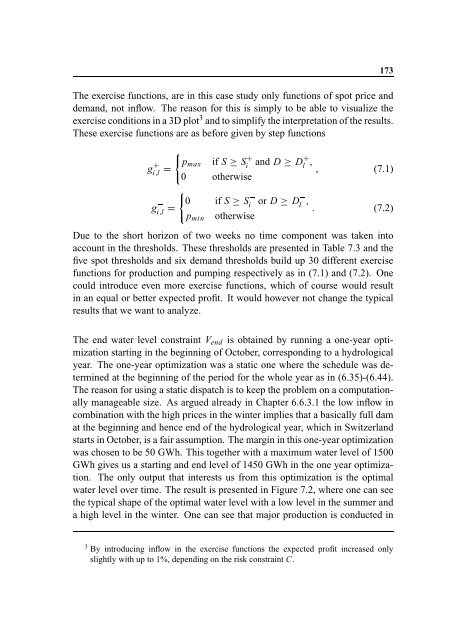Hedging Strategy and Electricity Contract Engineering - IFOR
Hedging Strategy and Electricity Contract Engineering - IFOR
Hedging Strategy and Electricity Contract Engineering - IFOR
Create successful ePaper yourself
Turn your PDF publications into a flip-book with our unique Google optimized e-Paper software.
S7 D7<br />
min 8<br />
0 if S<br />
i<br />
or D<br />
p otherwise<br />
l 6<br />
173<br />
The exercise functions, are in this case study only functions of spot price <strong>and</strong><br />
dem<strong>and</strong>, not inflow. The reason for this is simply to be able to visualize the<br />
exercise conditions in a 3D plot 3 <strong>and</strong> to simplify the interpretation of the results.<br />
These exercise functions are as before given by step functions<br />
g4i5 l<br />
p max if S S4i<br />
<strong>and</strong> D 6<br />
D4l<br />
0<br />
6 (7.1)<br />
otherwise<br />
i5 l<br />
g7<br />
(7.2)<br />
Due to the short horizon of two weeks no time component was taken into<br />
account in the thresholds. These thresholds are presented in Table 7.3 <strong>and</strong> the<br />
five spot thresholds <strong>and</strong> six dem<strong>and</strong> thresholds build up 30 different exercise<br />
functions for production <strong>and</strong> pumping respectively as in (7.1) <strong>and</strong> (7.2). One<br />
could introduce even more exercise functions, which of course would result<br />
in an equal or better expected profit. It would however not change the typical<br />
results that we want to analyze.<br />
The end water level constraint V end is obtained by running a one-year optimization<br />
starting in the beginning of October, corresponding to a hydrological<br />
year. The one-year optimization was a static one where the schedule was determined<br />
at the beginning of the period for the whole year as in (6.35)-(6.44).<br />
The reason for using a static dispatch is to keep the problem on a computationally<br />
manageable size. As argued already in Chapter 6.6.3.1 the low inflow in<br />
combination with the high prices in the winter implies that a basically full dam<br />
at the beginning <strong>and</strong> hence end of the hydrological year, which in Switzerl<strong>and</strong><br />
starts in October, is a fair assumption. The margin in this one-year optimization<br />
was chosen to be 50 GWh. This together with a maximum water level of 1500<br />
GWh gives us a starting <strong>and</strong> end level of 1450 GWh in the one year optimization.<br />
The only output that interests us from this optimization is the optimal<br />
water level over time. The result is presented in Figure 7.2, where one can see<br />
the typical shape of the optimal water level with a low level in the summer <strong>and</strong><br />
a high level in the winter. One can see that major production is conducted in<br />
3 By introducing inflow in the exercise functions the expected profit increased only<br />
slightly with up to 1%, depending on the risk constraint C.
















